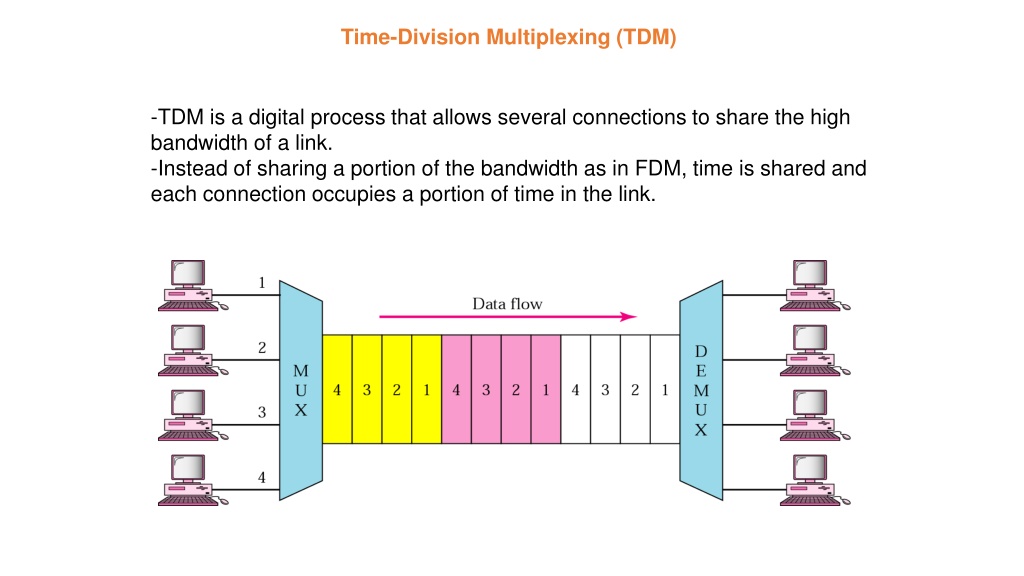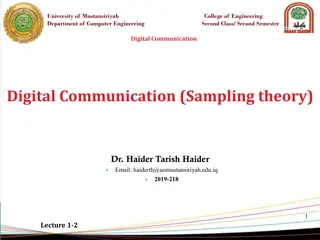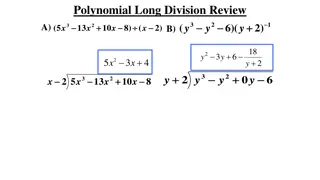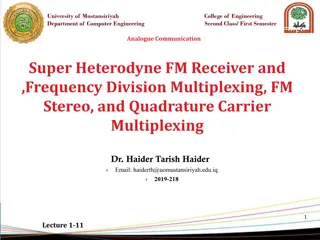Understanding Time-Division Multiplexing (TDM) in Digital Communication
Time-Division Multiplexing (TDM) is a digital process that enables multiple connections to share the bandwidth of a link by dividing data into time slots. Synchronous TDM organizes data flows into frames with specific time slots for each input connection. Frames are crucial for grouping time slots in TDM systems. Examples illustrate calculations related to TDM operations, such as bit duration, transmission rates, time slot durations, and frame durations. Frame synchronizing in TDM ensures proper alignment between multiplexer and demultiplexer using framing bits for accurate time slot separation.
Download Presentation

Please find below an Image/Link to download the presentation.
The content on the website is provided AS IS for your information and personal use only. It may not be sold, licensed, or shared on other websites without obtaining consent from the author. Download presentation by click this link. If you encounter any issues during the download, it is possible that the publisher has removed the file from their server.
E N D
Presentation Transcript
Time-Division Multiplexing (TDM) -TDM is a digital process that allows several connections to share the high bandwidth of a link. -Instead of sharing a portion of the bandwidth as in FDM, time is shared and each connection occupies a portion of time in the link.
Synchronous TDM - In synchronous TDM, the data flow of each input connection is divided into units, and the link combines one unit of each connection to make a frame. The size of the unit can be 1 bit or several bits. - For n input connections, a frame is organized into a minimum of ntime slots, each slot carrying one unit from each connection. -The data rate of the link that carries data from n connections must be n times the data rate of a connection to guarantee the flow of data. -The duration of a unit on a connection is 3 times that of the time slot in the frame (duration of a unit on the link).
-Time slots are grouped into frames. A frame consists of one complete cycle of time slots, with one slot dedicated to each sending device. - In a system with n input lines, each frame has n slots, with each slot allocated to carrying data from a specific input line. Interleaving
Example 1: Four 1-Kbps connections are multiplexed together. A unit is 1 bit. Find (a) the duration of 1 bit before multiplexing, (b) the transmission rate of the link (c) the duration of a time slot, (d) the duration of a frame. Solution : a. The duration of 1 bit before multiplexing is 1/1 Kbps, or 0.001 s (1 ms). b. The rate of the link is 4 times the rate of a connection, or 4 Kbps. c. The duration of each time slot is one-fourth of the duration of each bit before multiplexing, or 1/4 ms or 250 s. We can also calculate this from the data rate of the link, 4 Kbps.The bit duration is the inverse of the data rate, or 1/4 Kbps or 250 s. d. The duration of a frame is always the same as the duration of a unit before multiplexing, or 1 ms. We can also calculate this in another way. Each frame in this case has four time slots. So the duration of a frame is 4 times 250 s, or 1 ms. Example 2: Four channels are multiplexed using TDM. If each channel sends 100 bytes and we multiplex 1 byte per channel, show the frame traveling on the link, the size of the frame, the duration of a frame, the frame rate, and the bit rate for the link.
Frame Synchronizing The implementation of TDM is not as simple as that of FDM.Synchronization between the multiplexer and demultiplexer is a major issue. If the multiplexer and the demultiplexer are not synchronized, a bit belonging to one channel may be received by the wrong channel. For this reason, one or more synchronization bits are usually added to the beginning of each frame. These bits, called framing bits, follow a pattern, frame to frame, that allows the demultiplexer to synchronize with the incoming stream so that it can separate the time slots accurately. In most cases, this synchronization information consists of 1 bit per frame, alternating between 0 and 1,
AsynchronousTDM (Statistical TDM) -In synchronous TDM, each input has a reserved slot in the output frame. This can be inefficient if some input lines have no data to send. - In statistical time-division multiplexing, slots are dynamically allocated to improve bandwidth efficiency. Only when an input line has data to send is given a slot in the output frame. - In statistical multiplexing, the number of slots in each frame is less than the number of input lines. The multiplexer checks each input line in roundrobin fashion; it allocates a slot for an input line if the line has data to send; otherwise, it skips the line and checks the next line.
Addressing and overhead - A major weakness of asynchronous TDM is how dose the demultiplexer know which slot belongs to witch output line. - In synchronous TDM, the device to witch the data in a time slot belongs is indicated by the position of the time slot in the frame - In asynchronous TDM, data from a given device might be in the first slot of one frame and in the third of the next. - In the absence of fixed positional relationship, each time slot must carry an address telling the demultiplexer how to direct the data. This address for local use only, is attached by multiplexer and deleted by demultiplexer. - Adding address bits to each time slot increase the overhead of an asynchronous system and limits its efficiency























